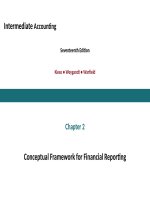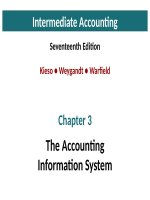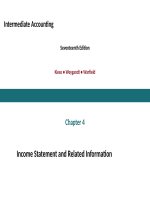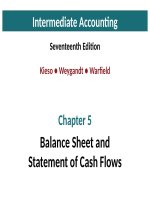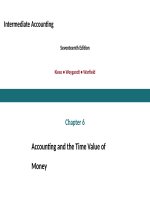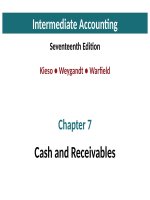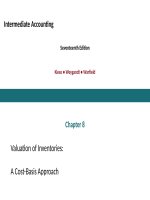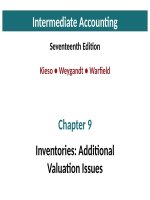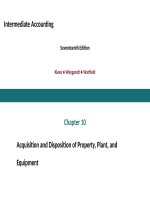Intermediate accounting 17e by kieso ch12
Bạn đang xem bản rút gọn của tài liệu. Xem và tải ngay bản đầy đủ của tài liệu tại đây (504.61 KB, 73 trang )
Intermediate Accounting
Seventeenth Edition
Kieso ● Weygandt ● Warfield
Chapter 12
Intangible Assets
This slide deck contains animations. Please disable animations if they cause issues with your device.
Learning Objectives
After studying this chapter, you should be able to:
1.
Describe the characteristics, valuation, and amortization of intangible assets.
2.
Describe the accounting for various types of intangible assets.
3.
Explain the accounting issues for recording goodwill.
4.
Explain impairment procedures and presentation requirements for intangible assets.
5.
Describe accounting and presentation for research and development and similar costs.
Copyright ©2019 John Wiley & Sons, Inc.
2
Preview of Chapter (1 of 2)
Intangible Asset Issues
Types of Intangibles
•
Characteristics
•
Marketing-related
•
Valuation
•
Customer-related
•
Amortization
•
Artistic-related
•
Contract-related
•
Technology-related
•
Goodwill
Copyright ©2019 John Wiley & Sons, Inc.
3
Preview of Chapter (2 of 2)
Impairment of Intangibles and Presentation
Research and Development Costs
•
Limited-life intangibles
•
Identifying R&D
•
Indefinite-life intangibles other than
•
Accounting for R&D
goodwill
•
Similar costs
•
Goodwill
•
Presentation
•
Presentation
Copyright ©2019 John Wiley & Sons, Inc.
4
LO 1: Discuss the Characteristics, Valuation, and Amortization of Intangible
Assets
Copyright ©2019 John Wiley & Sons, Inc.
5
Intangible Asset Issues (1 of 7)
Characteristics
1.
Lack physical existence.
2.
Not financial instruments.
Normally classified as long-term asset.
Copyright ©2019 John Wiley & Sons, Inc.
6
Intangible Asset Issues (2 of 7)
Common types of intangibles:
•
Patents
•
Copyrights
•
Franchises or licenses
•
Trademarks or trade names
•
Goodwill
The Coca-Cola Company's success comes from its secret formula for making Coca-Cola, not its plant
facilities.
Copyright ©2019 John Wiley & Sons, Inc.
7
Intangible Asset Issues (3 of 7)
Valuation
Purchased Intangibles
•
Recorded at cost
•
Includes all costs necessary to make the intangible asset ready for its intended use
•
Typical costs include:
Purchase price
Legal fees
Other incidental expenses
Copyright ©2019 John Wiley & Sons, Inc.
8
Intangible Asset Issues (4 of 7)
Valuation
Internally Created Intangibles
•
Recorded at cost
•
Generally expensed
•
Only capitalize direct costs incurred in developing intangible, such as legal costs
Underlying Concepts
The controversy surrounding the accounting for R&D expenditures reflects a debate about whether such expenditures meet the definition of an asset. If
so, then an "expense all R&D costs" policy results in overstated expenses and understated assets.
Copyright ©2019 John Wiley & Sons, Inc.
9
Intangible Asset Issues (5 of 7)
Amortization of Intangibles
Limited-Life Intangibles
•
Amortize to expense over useful life
•
Credit asset account or accumulated amortization
•
Useful life should reflect the periods over which the asset will contribute to cash flows
•
Amortization should be cost less residual value
•
Companies should evaluate the limited-life intangibles for impairment
Copyright ©2019 John Wiley & Sons, Inc.
10
Intangible Asset Issues (6 of 7)
Amortization of Intangibles
Indefinite-Life Intangibles
•
No foreseeable limit on time the asset is expected to provide cash flows
•
Must test indefinite-life intangibles for impairment at least annually
•
No amortization
International Perspective
IFRS requires capitalization of some development costs.
Copyright ©2019 John Wiley & Sons, Inc.
11
Intangible Asset Issues (7 of 7)
Amortization of Intangibles
Manner Acquired
Type of Intangible
Limited-life intangibles
Purchased
Capitalize
Internally Created
Expense*
Amortization
Over useful life
Impairment Test
Recoverability test and
then fair value test
Indefinite-life intangibles
Capitalize
Expense*
Do not amortize
Fair value test only
*
Except for direct costs, such as legal costs.
Copyright ©2019 John Wiley & Sons, Inc.
12
What do the Numbers Mean?
Are all Brands the Same?
Does it matter how a company builds brand value? In a word, yes. If the brand is internally developed, its value does not appear in the financial statements. This is
the case for The Coca-Cola Company, whose brand value is estimated to be roughly worth $79.2 billion but its balance sheet values its “trademarks within definitelives” (i.e., brands) at just $6.7 billion. As you are learning in this chapter, this reporting results because the accounting rules prohibit companies from recognizing
brands and many other “intangible” assets if they created them themselves. In contrast, when Procter & Gamble (P&G) acquired Gillette in 2005, it realized an
additional $24 billion in intangible assets on its balance sheet. That is, P&G paid $57 billion for Gillette and estimated the Gillette brand value to be worth $24 billion
of the total paid.
Some have criticized this inconsistency in accounting, noting that information about the value of a brand is important to investors in consumer-product companies.
Those supporting the difference in accounting cite the difficulty in arriving at reliable estimates of internally generated intangible assets. This latter argument seems
to be carrying the day in support of the current accounting, under which only purchased brands and other intangible assets are recognized in accounting reports.
Source: “Untouchable Intangibles: Sometimes You See Brands on the Balance Sheet, Sometimes You Don’t,” The Economist (August 30, 2014).
Copyright ©2019 John Wiley & Sons, Inc.
13
LO 2: Discuss the Accounting for Various Types of Intangible Assets
Copyright ©2019 John Wiley & Sons, Inc.
14
Types of Intangible Assets (1 of 9)
Six Major Categories:
1.
Marketing-related.
2.
Customer-related.
3.
Artistic-related.
4.
Contract-related.
5.
Technology-related.
6.
Goodwill.
Copyright ©2019 John Wiley & Sons, Inc.
15
Types of Intangible Assets (2 of 9)
Marketing-Related Intangible Assets
•
Examples:
Trademarks or trade names, newspaper mastheads, Internet domain
names, and non-competition agreements
•
In the United States trademarks or trade names have legal protection for
indefinite number of 10 year renewal periods
•
Capitalize acquisition costs
•
No amortization
Copyright ©2019 John Wiley & Sons, Inc.
16
Types of Intangible Assets (3 of 9)
Customer-Related Intangible Assets
•
Examples:
Customer lists, order or production backlogs, and both contractual and noncontractual customer relationships
•
Capitalize acquisition costs
•
Amortized to expense over useful life
Copyright ©2019 John Wiley & Sons, Inc.
17
Types of Intangible Assets (4 of 9)
Illustration: Green Market Inc. acquires the customer list of a large newspaper for $6,000,000 on January 1, 2020. Green
Market expects to benefit from the information evenly over a three-year period. Record the purchase of the customer list
and the amortization of the customer list at the end of each year.
Jan. 1 2017
Customer List
6,000,000
Cash
6,000,000
Dec. 31
2017
2018
2,000,000
Amortization Expense
2,000,000
Customer List *
2019
* or Accumulated Amortization
Copyright ©2019 John Wiley & Sons, Inc.
18
Types of Intangible Assets (5 of 9)
Artistic-Related Intangible Assets
•
Examples:
Plays, literary works, musical works, pictures, photographs, and video and audiovisual
material
•
Copyright granted for the life of the creator plus 70 years
•
Capitalize costs of acquiring and defending
•
Amortized to expense over useful life
Copyright ©2019 John Wiley & Sons, Inc.
19
Types of Intangible Assets (6 of 9)
Contract-Related Intangible Assets
•
Examples:
Franchise and licensing agreements, construction permits,
broadcast rights, and service or supply contracts
•
Franchise (or license) with a limited life should be amortized to expense
over the life of the franchise
•
Franchise with an indefinite life should be carried at cost and not
amortized
Copyright ©2019 John Wiley & Sons, Inc.
20
Types of Intangible Assets (7 of 9)
Technology-Related Intangible Assets
•
Examples:
Patented technology and trade secrets granted by the U.S. Patent and
Trademark Office
•
Patent gives holder exclusive use for 20 years
•
Capitalize costs of purchasing a patent
•
Expense any R&D costs in developing a patent
•
Amortize over legal life or useful life, whichever is shorter
Copyright ©2019 John Wiley & Sons, Inc.
21
Types of Intangible Assets (8 of 9)
Illustration: Harcott Co. incurs $180,000 in legal costs on January 1, 2020, to successfully defend a patent. The
patent’s useful life is 12 years, amortized on a straight-line basis. Harcott records the legal fees and the amortization
at the end of 2020 as follows.
Jan. 1
Patents
180,000
Cash
Dec. 31
180,000
Amortization Expense
15,000
Patents (or Accumulated Amortization)
Copyright ©2019 John Wiley & Sons, Inc.
15,000
22
LO 3: Explain the Accounting Issues for Recording Goodwill
Copyright ©2019 John Wiley & Sons, Inc.
23
Types of Intangible Assets (9 of 9)
Goodwill
Represents the future economic benefits arising from the other assets acquired in a business
combination that are not individually identified and separately recognized.
Only recorded when an entire business is purchased.
Goodwill is the ...
excess of cost of the purchase over the FMV of the identifiable net assets (assets less
liabilities) purchased.
Internally created goodwill should not be capitalized.
Copyright ©2019 John Wiley & Sons, Inc.
24
Recording Goodwill (1 of 8)
Illustration: Multi-Diversified, Inc. decides that it needs a parts division to supplement its existing tractor
distributorship. The president of Multi-Diversified is interested in buying Tractorling Company. The illustration
presents the statement of financial position of Tractorling Company.
Copyright ©2019 John Wiley & Sons, Inc.
25
